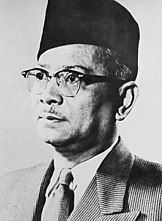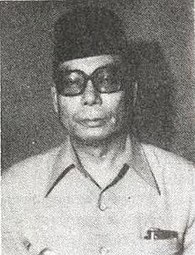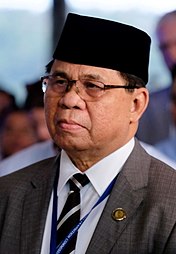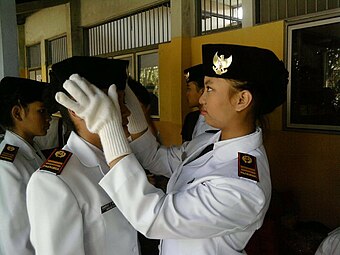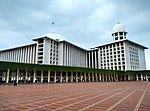Songkok
Indonesian leader Sukarno and Malaysian leader Tunku Abdul Rahman wearing a peci/songkok. | |
| Type | Traditional cap |
|---|---|
| Place of origin | Brunei, Indonesia, Malaysia, Singapore, Philippines |
The songkok or peci or kopiah is a
Names
It is called "songkok" in Sumatra and the Malay Peninsula.[2] While in Java, it is called "kopiah" or "kopeah".[3] It is also known widely in Indonesia as "peci", although the peci has a more elliptical shape and is sometimes decorated.[2]
Origin
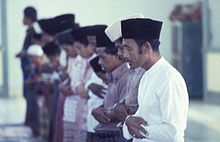
Kopiah (kupiah) is recorded as being used by
The Royal Malay Regiment of the Malaysian Army have been using the songkok as part of their uniform since under British rule.[11]
Current use

Traditionally, songkok is usually associated as a cap worn by Muslim men, during religious or formal state occasions. However, in Indonesia, the songkok has become the national headress with secular nationalist connotations made popular by Sukarno.[1] Numbers of Indonesian nationalist movement activist in early 20th century wore peci such as Sukarno, Mohammad Hatta, and Agus Salim. However, as the first president of Indonesia it was Sukarno that popularised peci — more precisely plain black velvet peci — as national men's cap of Indonesian,[12] and Indonesian male presidents have worn peci as part of their official presidential attire ever since. Indonesian official palace guards also wore peci as part of their uniform. The Paskibraka (Indonesian: pasukan pengibar bendera pusaka) or flag raising squad in Indonesian independence day ceremony also wear peci, and there is even female peci version with curved back. The Betawi people wear the Songkok as their traditional headdress usually colored dark red. Catholic and Protestant Betawi of Kampung Sawah regularly wear peci as part of traditional attire during church service.[13]

In Malaysia, traditional male Malay attire consists of a songkok, shirt, matching pants, and waist wrap that is called a
In Singapore, the songkok is not allowed to be worn in government schools, as part of the school uniform, as Singapore is officially a secular state and all religious headgear is not allowed to be worn.[
In the
Gallery
-
Indonesian independence activist of early 20th century (1930), including Sukarno, often wear peci, which give Indonesian peci current nationalist nuance.
-
Two Papuan raja wearing kopiah in Kokas, Fakfak (between 1933 and 1936).
-
Men of the Rejimen Askar Melayu DiRaja wearing songkok at bayonet practice, Singapore Island (1941).
-
A group of Bruneian men wearing songkok as part of Baju Melayu traditional Malay attire
-
Javanese Muslim men wearing kopiah and sarong
-
Indonesian President Joko Widodo and members of parliament wearing peci as part of national formal attire
-
EWP Tambunan, a Christian, was known for his habit of wearing red songkok.
-
Bangsamoro Region, southern Philippines
-
Female version of peci with curved back, worn by Indonesian flag raising girls squad (Paskibra)
See also
- Dhaka topi
- Gandhi cap
- Fez (hat)
- Tengkolok
- Yarmulke
References
- ^ a b Hendri F. Isnaeni (10 September 2010). "Nasionalisme Peci" (in Indonesian). Yahoo Indonesia News. Retrieved 10 September 2010.
- ^ a b c Rozan Yunos (23 September 2007). "The origin of the songkok or 'kopiah'". The Brunei Times. Archived from the original on 5 December 2008. Retrieved 13 April 2016.
- ^ Abdullah Mubarok (21 February 2016). "PDIP: Kopiah Bagian Dari identitas Nasional" (in Indonesian). Inilah.com. Archived from the original on 13 April 2016. Retrieved 13 April 2016.
- ^ Ras, Johannes Jacobus (1968). Hikajat Bandjar: A Study in Malay Historiography. The Hague: Martinus Nijhoff.
- ISBN 978-602-9346-00-8.
- ^ Hikayat Banjar, 6.3: Maka kaluar dangan parhiasannya orang barbaju-rantai ampat puluh sarta padangnya barkupiah taranggos sakhlat merah, orang mambawa astenggar ampat puluh, orang mambawa parisai sarta padangnya ampat puluh, orang mambawa dadap sarta sodoknya sapuluh, orang mambawa panah sarta anaknya sapuluh, yang mambawa tumbak parampukan barsulam amas ampat puluh, yang mambawa tameng Bali bartulis air mas ampat puluh. (See Ras 1968, p. 302) Translation: "So came out with their ornaments men with chain mail numbered forty alongside their swords and red kopiah [skull cap], men carrying astengger [arquebus] numbered forty, men carrying shield and swords numbered forty, men carrying dadap [a type of shield] and sodok [broad-bladed spear-like weapon] numbered ten, men carrying bows and arrows numbered ten, (men) who carried parampukan spears embroidered with gold numbered forty, (men) who carried Balinese shields with golden water engraving numbered forty."
- ISBN 9788828100140.
- JSTOR 29754279– via JSTOR.
- ^ Hussain, Khalid Muhammad, ed. (1986). Hikayat Iskandar Zulkarnain (2nd ed.). Kuala Lumpur: Dewan Bahasa.
- ^ Syair Siti Zubaidah MCP text
- ^ Journal of the Society for Army Historical Research. Society for Army Historical Research. 1996.
- ^ Yusep Hendarsyah (28 April 2011). "Peci Hitam dan Identitas Paling Indonesia". Kompasiana. Archived from the original on 12 August 2012. Retrieved 28 March 2012.
- ^ Ramadhian, Nabilla (27 December 2022). "Cerita di Balik Jemaat Misa Natal Gereja Kampung Sawah yang Pakai Baju Adat Betawi Halaman all". KOMPAS.com (in Indonesian). Retrieved 12 January 2023.
- ISBN 978-983-068-579-3.
- ^ http://www.istiadat.gov.my/wp-content/uploads/2020/12/3.-Pakaian-Rasmi-Istiadat-No.-1-Dress-Bagi-Ahli-Parlimen-dan-Ahli-Dewan-Negara-Siang.pdf [bare URL PDF]


